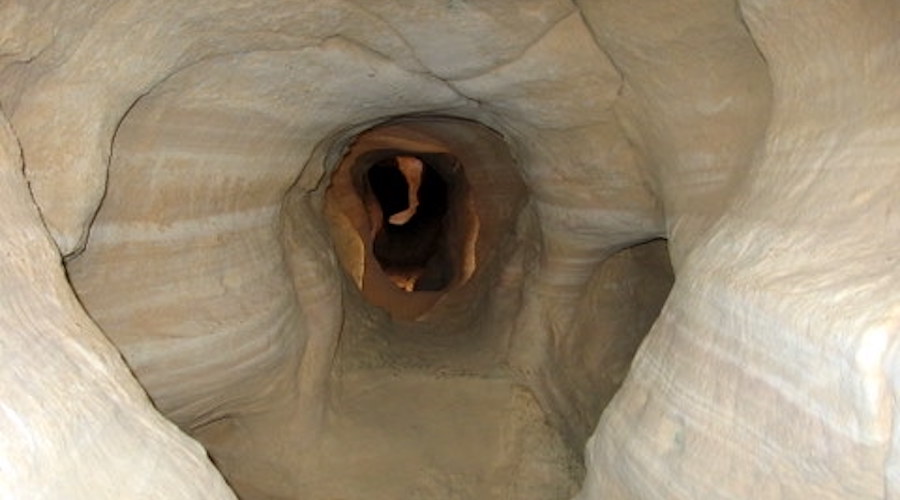Biblical copper mines’ environmental impacts lasting to this day


Researchers from Tel Aviv University have discovered that the ancient copper industry at Timna was not managed in a sustainable manner, with overexploitation of local vegetation eventually leading to the disappearance of both the plants and the industry.
To reach these conclusions, the scientists collected samples of charcoal used as fuel for metallurgical furnaces in Israel's southern desert, during the 11th to 9th centuries BCE and examined them under a microscope. They found that the charcoal fuels used changed over time, with the earlier samples containing higher quality firewood than the later samples.
Following the demise of good quality fuels, copper production was not renewed in the area until about a thousand years later. However, the local environment has not recovered fully to this day.
“Many findings in the Timna Valley indicate that a vast copper industry flourished here for a period of about 250 years, between the 11th and 9th centuries BCE, with thousands of mining sites, and about 10 processing sites that used furnaces to extricate copper from the ore,” said Erez Ben-Yosef, co-author of the paper reporting on these findings.
“This impressive operation is known to the public as 'King Solomon's Mines,' and today we know that copper production actually peaked here at about the time of Kings David and Solomon. The Bible never mentions the mines as such, but it does tell us that David conquered the area of Timna, known at the time as Edom, placing garrisons throughout the land, so that the Edomites became his subjects; and that his son Solomon used huge quantities of copper for building the Temple in Jerusalem,” Ben-Yosef pointed out.
According to the researcher, it is possible to assume that David took an interest in this remote desert region because of its copper—an important and valuable metal at the time, used for making bronze among other purposes.
He explained that the Timna copper industry was run by the local Edomites, who were mining experts, and copper from Timna was exported to distant lands, including Egypt, Lebanon, and even Greece.
“This study shows, however, that the industry was not sustainable, a fact that may fit in well with occupation by a foreign power, perhaps ruled from Jerusalem,” Ben-Yosef said.
In the paper, the scientist and his team explain that Timna's copper industry was highly advanced for its time and that the metalsmiths who processed the copper were skilled and well-respected individuals.
Copper was extracted from ore via smelting in earthenware furnaces at a temperature of 1,200 degrees Celsius. The entire process took about eight hours, after which the furnace was smashed, and the copper retrieved from its base. The wood charcoal required to attain the high temperature was manufactured beforehand at special sites, by slow combustion of trees and bushes cut down for this purpose.
“The copper industry at Timna was first discovered about 200 years ago, and ever since, every researcher who visited the area has asked the same question: What fuel was used to heat the smelting furnaces? Since vegetation is very sparse in this desert area, where did the firewood come from? To finally solve this mystery, we collected samples of charcoal from the smelting sites and examined them in the lab,” lead author Mark Cavanagh said.
At the lab, the group examined more than 1,000 charcoal samples under an electronic microscope. The anatomic structure of the original wood is preserved in the charcoal and under the microscope, the species were identified. The samples were dated according to the layer of the waste mound in which they had been found, and some were also sent out for carbon-14 dating.
“We found significant changes in the composition of the charcoal as time went on. Charcoal from the bottom layer of the mounds, dated to the 11th century BCE, mostly contained two plants known to be excellent burning materials: 40% acacia thorn trees, and 40% local white broom, including broom roots,” Cavanagh said. “About 100 years later, around the middle of the 10th century BCE, we saw a change in the makeup of the charcoal. The industry had begun to use fuel of a lower quality, such as various desert bushes and palm trees. In this latter stage, other trees were imported from far away, such as junipers from the Edomite plateau in present-day Jordan, covering distances of up to 100 kilometres from Timna, and terebinth, also transported from dozens of kilometres away.”
The researchers claim that the gradual change in the contents of the charcoal resulted from overexploitation that had destroyed the natural resources—in this case high-quality firewood, acacia and white broom.
“Based on the amount of industrial waste found at the processing sites we can calculate the quantity of woody plants required for producing copper. For example, the production site called the 'Slaves' Hill,' which was only one of several sites operating simultaneously, burned as many as 400 acacias and 1,800 brooms every year,” Ben-Yosef said. “As these resources dwindled, the industry looked for other solutions, as evidenced by the changing composition of the charcoal. However, transporting woody plants from afar did not prove cost-effective for the long run, and eventually, during the 9th century BCE, all production sites were shut down.”
In his view and that of his colleagues, this study indicates that 3,000 years ago humans caused severe environmental damage in the Timna Valley, which affects the area to this day.
“The damage was caused through overexploitation, especially of the acacia and white broom, which, as key species in the ecosystem of the Southern Arava, had supported many other species, stored water, and stabilized the soil. Their disappearance generated a domino effect of environmental damage, irreparably harming the entire area,” co-author Dafna Langgut said. “Three thousand years later, the local environment still hasn't recovered from the crisis. Some species, like the white broom, once prevalent in the Timna Valley, are now very rare, and others have disappeared forever.”
THIS ARTICLE WAS FIRST POSTED ON MINING.COM
Comments